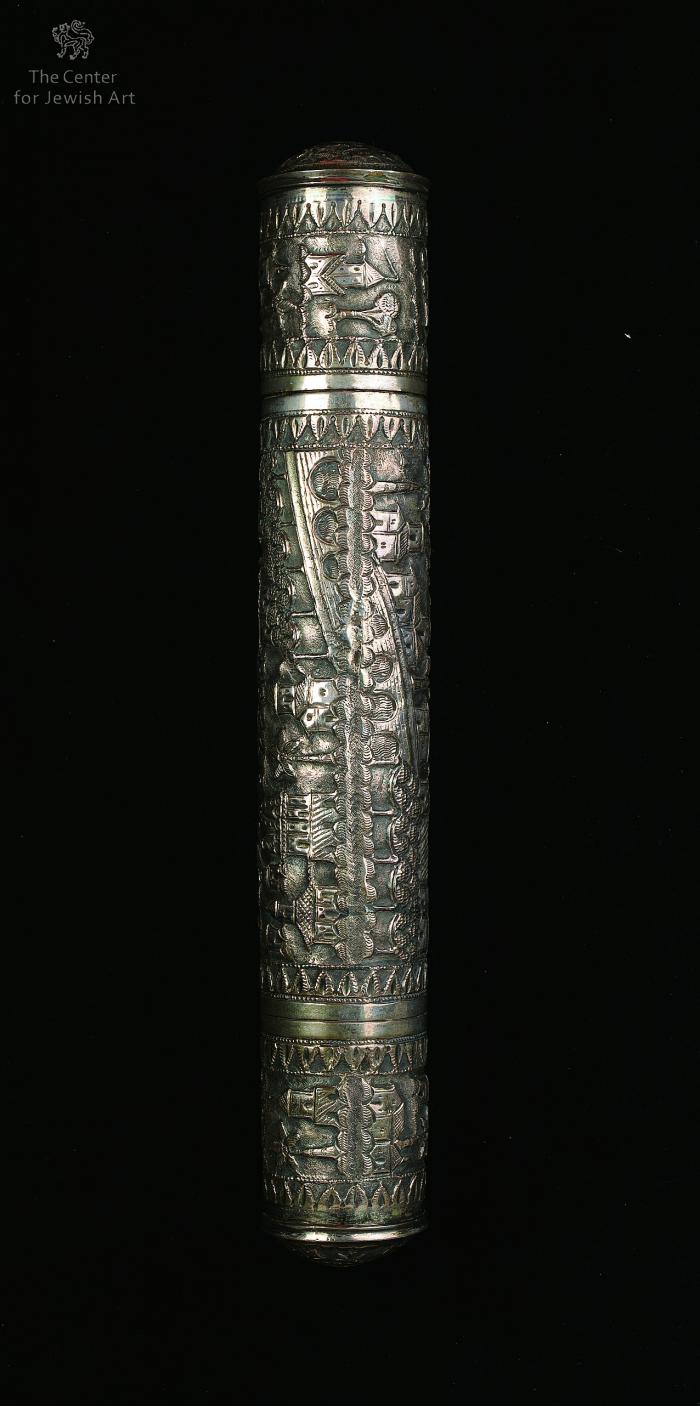Img. ID: 346227

A silver case decorated with Israeli cityscapes in which the scroll is stored.
The length of the sheets in the scroll: 1) ca. 620 mm, 2) 465 mm, 3) ca. 590 mm (the sheet is stitched to the roller).
Dimensions of the selected details in the scroll:
- text panel: 140x92 mm;
- decorations between the text panels: 138x28 mm;
- frames with illustrations: 48x85 mm;
- decorations between the illustrations: 48x32 mm;
- an average letter: just over 2 mm;
- letters in col. 13: 5 mm.
The case: 330 mm (height with a lid).
The sheets are dirty, crumpled (this influenced the state of preservation of the text), and stained.
The third sheet is preserved in the best condition but it is wavy.
The case is well preserved.
The Book of Esther in Hebrew
The scroll is formed of 3 sheets containing 15 columns of the text with 25 lines except for col. 1 with 19, and col. 13 with 11 lines divided into two half-columns.
Every sheet contains 5 columns of the text.
The text is written in the Hebrew square Ashkenazi script, in almost black ink, on the flesh side of the parchment membranes. The side of the text and decorations is brighter and smoother than the other side that is darker and more suede.
The letter ח (Es. 1:6) is not well preserved but it seems that its legs could end with tiny "hooks". The letter ת (Es. 9:29) is not highlighted. Enlarged and diminished letters are included in col. 13.
The initial word is written in enlarged letters placed in a decorative frame.
The ruling - horizontal and vertical lines - is made with a hardpoint. The lines are marked along with the membranes.
The pricking on the right edge of the first sheet can be seen. The holes are marked every 2 mm, therefore, the scribe could insert the letters between the upper and lower lines.
The membranes in the scroll are glued together.
Several Hebrew inscriptions are penned in the manuscript:
1) below col. 2: מתנה הוא ממני חתם מטא לב''א שמעון בן הק'' כ'' אייזק כ''ץ אלצייא (?)הקטן יוספון תאומים - "This is a gift from me, signed / below to respectful brother (?) Shimon / the son of the small respectful Aizek Katz. / [Here] – Alzey / The small Yosefon Teomim (?)";
2) on the blank side of sheet no. 2: הקטן אהרן בן כ"ה אייזק כץ יצ"י מאלצייא הקטן אהרן בן כ"ה אייזק כ"ץ יצחק מאלצייא - "The small Aaron the son of respectful / Aizek Katz, may Lord protect him / from Alzey / the small Aaron the son of respectful Aizek / Katz Yitzhak from Alzey";
3) on the blank side of sheet no. 3: המגילה הלז נתתי במתנה גמורה לאחי הע' ר' אהרן שי' פורי' תקל"ט לפ"ק ולראי' בעה"ח [באתי על החתום] הק' שמעון ב"ה אייזק כ"ץ שי' מאלציא - "Respectful Aaron may he live, Purim 1779 / To certify this, I sign, the small Shimon son of Aizek Katz, / may he live, from Alzey".
Some details in the scroll are based on the ornamentation of the groups of popular Amsterdam scrolls produced in the early 18th century (in the Index see for the "scrolls with landscapes" and "scrolls with portrait medallions").
Men mentioned in the inscriptions (see "Scribal notes") say about themselves "from Alzey". The town of Alzey (Rhineland-Palatinate) may be taken into account as a possible place of the manuscript's creation.
The case may be produced in the 19th century by Lambert & Rawlings because the scroll is accompanied by a small sheet with an English inscription: "Roll of the hole Scriptures / written in Hebrew / The Book of Esther / called Magilly (sic!) to (?) read /at the festival of Purim." It is inscribed on the letterhead of Lambert Goldsmiths: "Exhibited by / Lambert / Goldsmiths to the Queen [Victoria], / 10, 11, 12 Coventry Street, / London." The Goldsmith Lambert & Rawlings operated at the already mentioned address between 1827 and 1839. There is also a kind of a small letter dated 2nd July 1869 (?) with a red penny postal stamp (in use during 1841-1879) addressed at the same address. On its other side, there is a short - partly legible - inscription in ink: "Purim / Aaron Cohn (?)... / Metz (?) / Esther." There is a small sticker on the backside of the first sheet saying: "Art Treasures Exhibition, Wrexham, 1876. Lambert Proprietor". Only the name of Lambert is written in pencil, the erst is printed. The exhibition was opened on July 22nd, 1876. Just above, there is another sticker with the number 294.
Unknown



